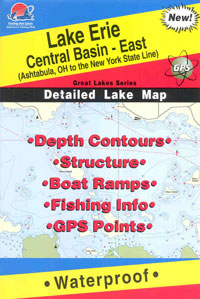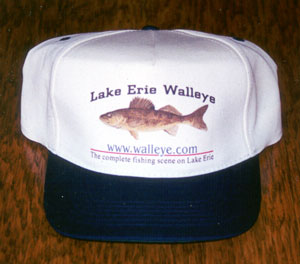Early Season Erie
Walleyes
by Rick Olson
The overall winner and undisputed champion is none other than Lake
Erie and it still retains the “Best Fishery in the World” title. Even
though things have changed and loading the boat with
 giant
eye popping walleyes isn’t as easy as it used to be it’s still good,
real good. Real good means you can still have days reminiscent of an era
gone by, and includes solid catches of six, seven, and eight pounders.
Throw in a serious shot at a big hawg and you have what’s available now,
especially this time of the year.
giant
eye popping walleyes isn’t as easy as it used to be it’s still good,
real good. Real good means you can still have days reminiscent of an era
gone by, and includes solid catches of six, seven, and eight pounders.
Throw in a serious shot at a big hawg and you have what’s available now,
especially this time of the year.
The big average of old has been on the slide as of late and is
biological matter. Brain samples were taken from fish caught during a
recent tournament which provides a more accurate method for aging fish,
and the results were surprising! What the researchers found was that the
ten to fourteen pounders were actually twenty years old! The fact is the
huge year class that had been a big part of angler’s catches in recent
years has reached the limits of it’s natural life expectancy and is
dying off. I’ve been fortunate enough to have had the opportunity to
follow and take advantage of this big class and have been fishing at
least one tournament on Erie ever year for the last thirteen years. Even
though a big class is on it’s way out there’s more coming to fill the
gap, it just takes time.
Late May and early April is one of the best times to be on the big
water as it coincides with the end of the spawning period. Although the
post spawn period is usually associated with some of the toughest
conditions you’ll ever be faced with , Erie is definitely the exception.
You can find the key to overcoming these tough fishing conditions in
the numbers. The spawning season is a time of the year when walleyes
bunch up in heavy concentrations, on or near major spawning reefs and
shoals. Lake Erie is no exception and the walleyes stack into these
aforementioned areas like nowhere else on earth. With that many fish
bunched up into limited confines, the odds of finding a few biters
starts to get better and better.
Although some of the Lake Erie spawn occurs in it’s numerous incoming
rivers and streams, most takesplace on it’s rocky reefs and bars. Many
of these spawning reefs are located in the western most part of the
lake, and include the Bass Islands and all points west. Walleyes that
roam the main part of the lake for much of the year, begin a migration
that leads them into the western basin by early spring. The rocky
reefs and bars are easily found on any of the many good maps that are
available, and are the very place where you should start your search.
Some of the best reefs are smack dab in the middle of the Camp Perry
firing range and can be fished, but pay attention and be on your way
when the warning siren is sounded. Buoys A,B,C,D and E are in harms way
and all mark reefs that see major concentrations of spawning fish.
Although you would normally expect spawning activities to take place
in shallow water, the Erie reefs are an exception to the rule, and the
deeper structure should not be overlooked. These reefs will attract and
hold smaller male walleyes for up to three or four weeks, and can make
for some fantastic fishing. They are easily fished by simply throwing
out an anchor and working vertically with a jig tipped with a minnow.
It’s pretty basic but can be a real gas, especially when you’re getting
hit on every drop and when you pull a fish to the surface and see four
or five fish following it in.
While the top of the reefs can really heat up, it’s not the place to
catch the real hawgs. Those are the females which are the larger of the
species and can be found close by, but require a completely different
approach.
To get in on the big fish, try looking down and out. Females don’t
seem to waste much time when it comes to the spawning cycle as they move
in, drop their eggs, and then move off. They’ll often head to the first
break or drop-off and take a little time to rest, laying and
recuperating in deeper water. Even on Erie fish that are spawning, or
have just finished, are not very catchable. Walleyes don’t all spawn at
the same time however, and plenty of fish can be found in the various
stages. The ones to key on are the fish that have yet to spawn, and
those that have had a week or two to recuperate.
To get in on the action you can try dragging a jig and minnow along
the base of the drop off. Because you’ll be working deeper water, a
heavier jig is in order. Jigs in the 3/8 to 1/2 oz. range tipped with a
minnow are the ticket. A simple lift and drop is about all the action
you’ll need to trigger a strike. The next place to look is the
open water, beyond any type of structure. As big walleyes become active
they’ll suspend in open water, relating to nothing but their next meal.
They are easily marked on a good graph like the Raymarine C80 which has
a dual cone transducer. The C80 has a transducer with both an 11 degree
and 45 degree cone, and the wide angle 45 degree beam takes a wide swath
which can help toquickly eliminate water. If you’re not marking fish
they’re not there and you better keep moving until you do.
As previously mentioned active walleyes will suspend, but when
they’re not riding high they can often be found holding tight to the
bottom, even if the bottom is mud or silt. A passing cold front can push
them tight to the bottom but may still be caught. Even if they’re a
little off, at least a few of those fish holding tight can be caught. A
bottom bouncer and a spinner and live bait combo is one of the best ways
to yank walleyes that are glued to the bottom.
Spinners and crawlers trolled behind bottom bouncers are a top pick
for bottom hugging walleyes and bigger blades in sizes #4 or #5 are what
the situation calls for. The bigger blades get noticed and remember;
you’re fishing for Lake Erie walleyes which are much bigger on average
than just about anywhere else.
Another consideration is water temperature as spinner rigs become
more productive in the fifty degree and above range. If you’re dealing
with fifty degree and colder water temps you might be better off
sticking with crankaits, which are better cold water producers.
As conditions begin to stabilize and the weather steadily improves,
more and more fish will lift off the bottom and suspend which can make
for peak fishing conditions. When that happens trolling crankbaits
becomes the most effective means for putting huge numbers of walleyes in
the boat. Crankbaits like the Husky Jerk and Deep Husky Jerk can prove
to be too much for all those eyes to resist.
To get a bait to ride at the right depth you’ll probably have to
experiment and there are several ways to get the job done. One includes
using a crank that will dive to the desired depth and another involves
using lead core line, inline weights, and snap weights. A shallow
running bait can be run at just about any depth with the addition of
weight and adding an inline weight keeps it simple. The problem though
is that you tend to lose fish when it gets rough and when you would be
better off switching to snap weights which can be added and removed
fifty feet or more in front of the bait.
Another early season pattern involves working shallow water fish
inside the big spawning reefs and the action can be phenomenal. Trolling
cranks like #7 or #9 Shad Raps along seven to ten foot shoreline
breakscan produce lots of fish and most will be on the smaller side, but
there are some monsters the occasionally get caught.
The overall riding factor that can effect your early season Erie
success is weather, particularly wind. Wind can turn clear water to mud
overnight, and completely shut down the hottest action. Once it gets
stirred up it might take at least a couple of days of settling out to
clear things up enough to get it all going again If you’re faced with
muddy conditions try to find the clearest water you can, which typically
lies east of the islands.




 giant
eye popping walleyes isn’t as easy as it used to be it’s still good,
real good. Real good means you can still have days reminiscent of an era
gone by, and includes solid catches of six, seven, and eight pounders.
Throw in a serious shot at a big hawg and you have what’s available now,
especially this time of the year.
giant
eye popping walleyes isn’t as easy as it used to be it’s still good,
real good. Real good means you can still have days reminiscent of an era
gone by, and includes solid catches of six, seven, and eight pounders.
Throw in a serious shot at a big hawg and you have what’s available now,
especially this time of the year.